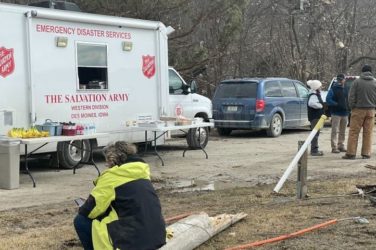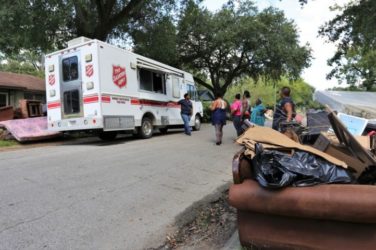Since 1988, amateur “ham” radio operator volunteers have had a remarkable impact on the world in times of disaster thanks to SATERN (Salvation Army Team Emergency Radio Network). These trained men and women often are the only link to the outside world during disasters when cell phones towers are down, land lines are damaged and electrical power is out.
SATERN was the brainchild of then-Captain Patrick McPherson, a Salvation Army officer who at the time was leading a corps and serving as the emergency disaster services (EDS) coordinator for the Heartland Division. The first network consisted of four people, including two Canadian Salvationists. Two months later, SATERN aided emergency responders in its first international response when Hurricane Gilbert battered the Caribbean for nine days, killing 341 people.
In 1990, now Major Pat McPherson was named the Metropolitan Division’s EDS director. A week later, a horrific, F5 tornado hit Plainfield, Ill., killing 29 people and causing $200 million in damages. SATERN required 64 operators daily for 11 days. One of those operators, volunteering for the first time, was Bill Shillington, who now oversees SATERN operations in the Central Territory.
In 1993, more than 1,000 miles of Mississippi River flooding required a multi-state SATERN response. A year later SATERN assisted at the American Eagle airline crash in Indiana in which 68 lives were lost. In 1995, SATERN operator Bill Shillington took a Salvation Army canteen to earthquake-stricken Kobe, Japan, where 5,500 died and 26,000 were injured.
In the late 1990s, SATERN volunteers responded to the Grand Forks River flooding in North Dakota and Minnesota and disasters in Turkey, Honduras and Nicaragua. During the Atlantic Coast’s Hurricane Mitch in 1998, the Federal Communications Commission (FCC) officially designated SATERN’s radio frequency for emergency use, and SATERN became an official Salvation Army program with Major PatMcPherson appointed as its national director.
During the 9/11 crisis in 2001, SATERN sprang into action with operators coordinating countless emergency responses. A SATERN North America Command was set up at Central Territorial Headquarters, and Australian and German stations coordinated “Stand by for America” assistance. The National Association for Amateur Radio produced a video narrated by Walter Cronkite highlighting the disaster services work of The Salvation Army and SATERN. Later that year SATERN facilitated EDS responses as wildfires engulfed portions of Western states.
After four hurricanes blasted Florida and the Bahamas in 2003, SATERN was nationally heralded for its person-location operations. When Hurricanes Katrina and Rita hit the Gulf Coast in 2005 leaving 1,800 dead, international SATERN volunteers ran full force for 20 days. Operators saved lives by directing emergency personnel to people trapped on rooftops. Over 61,000 person-location requests come in at a rate of 20 per second, of which SATERN located 25,508 people. By 2007, the Department of Homeland Security assigned call signs to three SATERN administrators.
Today with a national membership around 4,600 trained operators and countless more volunteer operators around the world willing to lend aid when needed, SATERN stands ready to serve at a moment’s notice with the latest in state-of-the-art, satellite-linked equipment. More than 40 SATERN on-the-air net meetings are held weekly. SATERN operators also participate in EDS training classes.



